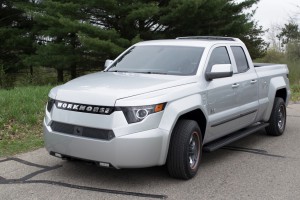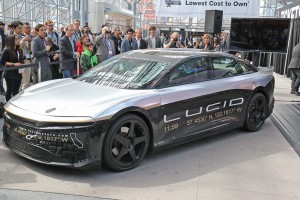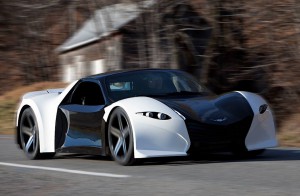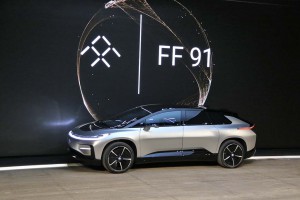Much of the attention about electric vehicles these days really centers on two vehicles: Tesla’s Model 3 and Chevy’s Bolt while the Nissan Leaf occasionally makes some noise.
It can be easily argued that it makes sense that these vehicles should enjoy the spotlight since they are the most practical versions of vehicles that we already drive, albeit in gasoline-powered iterations. However, what gets lost in the shuffle are the other players, such as recently introduced Tomahawk, coming to the market.
Admittedly, not as practical as the other three, and even Tesla’s other two options, the Model S and Model X, the Tomahawk is almost pure adrenaline.
The new Tomahawk, which is set to start production next year, offers neck-and-spine snapping torque and power, doing 0 to 60 mph in just two seconds in “Race Mode,” and just double that in “Street Mode,” according the Dubuc Motors, the start-up company looking to be one of many of the current “bit” players to emerge from the shadows to be get a piece of the electric vehicle pie.
“We are pushing the envelope in terms of what is possible in the automotive industry to create a wow experience for our customers every time they get behind the wheel” says co-founder Mike Kakogiannakis.

Putting out 460 horsepower, the W15 electric pickup is designed to be the ideal pickup truck, especially for fleet usage, according to Workhorse executives.
(EV maker Lucid looks to Challenge BMW, Mercedes. Click Here for the story.)
The Tomahawk, in terms of the exterior, is everything that the Tesla Model 3 is not. It’s a macho looking car, clad in enough carbon fiber to make one wonder if you park it or moor it in hopes it doesn’t float away. Putting out 800 horsepower and 1,000 ft-lb of torque, the street-legal beast also boasts a range of 370 miles on a single charge, according to the company.
It gets its power from four small electric motors on each wheel, and it features the standard list of safety and convenience features expected for a vehicle like this. And while this thing should be raking in orders from power-hungry EV mavens, it’s actually in the midst of an ongoing crowdfunding IPO to push its operations along.
However, this tenuous, let’s-do-it-on-a-shoestring approach to EVs is almost the norm rather than the exception these days when one does a little deeper dive on the latest in electric vehicles coming to the market, or at least claiming to do so.
The recently introduced Workhorse W15 pickup, also scheduled for full production in 208, offers 460 hp and a 0-to-60 mph time of 5.5 seconds. While the all electric range isn’t great – just 80 miles – as a hybrid it’ll exceed 300 miles on a tank, the company claims.

This Lucid Air prototype set a new record pushing 217 mph on a track using electric motors on each axle.
The pickup also features a pair of electric engines, including one on each axle, which together can generate 460-hp plus more torque than a Hemi V8 diesel engine in a heavy-duty pickup. Designed for fleet use, the company says the 80-mile charge satisfies most of the driving demands for fleet usage.
(Click Hereto see more about Faraday’s plans to redefine its future with the FF91.)
“When we introduced it… we suddenly had tons of requests from consumers to buy it,” Workhorse CEO Steve Burns said. “We were caught a little off guard.”
In fact, the company has 5,000 orders for the $50,000 truck. The company plans to build the trucks in Union City, Indiana. Pricing details haven’t been finalized.
Other EV companies are on the cusp of rolling out new vehicles as well, or claim to be, such as Faraday Future, which has several prototypes and broke ground on a plant in Nevada about a year ago, but is rumored to be in dire financial straits.
Lucid Motors unveiled its car, aimed at challenging BMW and Mercedes, at this year’s New York International Auto Show. It’s aiming for production in 2019, for its 400-plus horsepower rocket that was clocked at 217 mph on a track.
Of course, there is also the NIO EP9, which was billed as the fastest EV in the world when it debuted, the NIO EP9 overpowers the competition with 1,341 horsepower and a top speed near 200 miles per hour.
On top of these newcomers, which is just some of the offerings, the “old guard,” led by Tesla, has been improving its performance as well as expanding its product offerings. In fact, Tesla has plans for a pickup truck and just recently, the company’s CEO, Elon Musk, spoked during an interview about how much fun it was to drive the company’s semi-truck prototype.
(Click Here to find out why VW says “the future is electric.”)
When Volkswagen AG executives recently proclaimed the “future is electric,” they may have not understood the magnitude of the statement. Every major automaker is substantively invested in developing not just an electric vehicle, but a line-up of EVs and in many cases, those vehicles are intertwined with each company’s autonomous vehicle efforts.


